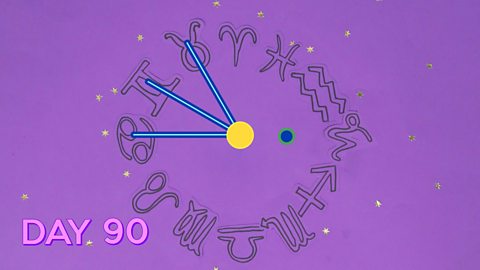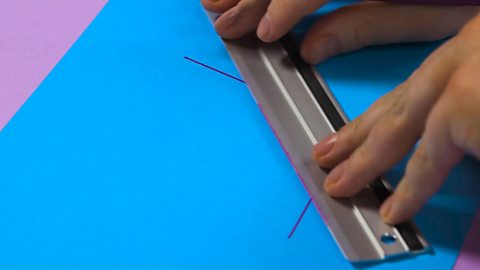An acute angle
An acute angle is less than \(90^\circ\).
A right angle
A right angle is exactly \(90^\circ\)
An obtuse angle
An obtuse angle is between \(90^\circ\) and \(180^\circ\).
A straight angle
A straight angle or an angle on a straight line is exactly \(180^\circ\).
A reflex angle
A reflex angle is between \(180^\circ\) and \(360^\circ\).
A full turn/complete revolution
A full turn or complete revolution is exactly \(360^\circ\).
Estimating angles
To estimate the size of an angle, try thinking in terms of counting in quarter turns, or right angles.
For example, the angle in the following diagram is acute - the line turns less than a right angle to get to the other line, so it must be between \(0^\circ\) and \(90^\circ\).
The angle in the following diagram is a reflex angle.
The line turns through more than two right angles, but less than three right angles, so is between \(180^\circ\) and \(270^\circ\).
To be even more accurate think in terms of \(45^\circ\) angles.
This angle lies somewhere between \(90^\circ\) and \(135^\circ\), but seems slightly closer to \(135^\circ\), so you could estimate that it is \(120^\circ\).
Drawing angles
Often three letters are used to describe an angle.
For example, angle LMN is shown here:
Follow these steps to draw the angle \(PQR = 60 ^\circ \)
- Draw the line QR.
- Place your protractor on the line QR. Ensure that the centre of your protractor is over the point Q. Make a mark at \(60^\circ\).
- Remove the protractor and join Q to the \(60^\circ\) mark. Label this point P.
- If necessary, mark the angle.
Measuring angles
When measuring angles, make sure that the centre of the protractor is over the vertexThe point where two lines meet is called the vertex. In a 3D shape this is the corner point. (corner) of the angle and that the base line of the protractor is along one of the lines of the angle.
Question
Use the protractor to measure the following angle:
Answer
\(40 ^\circ \)
Question
Use the protractor to measure the following angle:
Answer
\(70 ^\circ\)
Question
Use the protractor to measure the following angle:
Answer
\({135}^\circ\)
Question
Use the protractor to measure the following reflex angle:
Answer
The reflex angle is:
\({360}^\circ - {120}^\circ = {240}^\circ\)
Angles at a point and angles in a straight line
There are \(360^\circ\) in a complete turn.
There are \(180^\circ\) in half a turn (a straight line).
Question
Find the size of angle \({z}\):
Answer
There are \(360^\circ\) in a complete turn, so \(z + 40 + 110 + 130 = 360\)
\(z + 280 = 360\)
\(z = 80 ^\circ \)
Question
What is the size of angle \({p}\)?
Answer
The angles on a straight line add up to \(180^\circ\), so \(p + 140 = 180\).
\(p = 40 ^\circ \)
Angles in a triangle
The angles in a triangle add up to \(180^\circ\).
Angles in a quadrilateral
The angles in a quadrilateral add up to \(360^\circ\).
This works for any quadrilateral.
Equilateral triangle
An equilateral triangle has \({3}\) equal sides and \({3}\) equal angles.
Isosceles triangle
An isosceles triangle has \({2}\) equal sides and \({2}\) equal angles.
Question
What is the size of angle \({p}\)?
Answer
This is an isosceles triangle, so both the bottom angles are \({p}\).
The angles in a triangle add up to \({180}^\circ\), so:
\(p + p + 40 = 180\)
\(2p + 40 = 180\)
\(2p = 140\)
\(p = 70\)
So the missing angles are both \(70^\circ\).
Test section
Question 1
What kind of angle is this?
Answer
An angle between \({90}^\circ\) and \({180}^\circ\) is obtuse.
Question 2
What kind of angle is bigger than \({180}^\circ\)?
Answer
A reflex angle is bigger than \({180}^\circ\).
Question 3
Estimate the size of this angle:
Answer
The correct answer is: \({150}^\circ\)
So a good estimate would be between \({140}^\circ\) and \({160}^\circ\) as we know it is an obtuse angle.
Question 4
Estimate the size of this angle:
Answer
The correct answer is: \({30}^\circ\)
So a good estimate would be between \({20}^\circ\) and \({40}^\circ\) as we know it is an acute angle.
Question 5
What is the size of this angle?
Answer
The correct answer is: \({70}^\circ\)
To read the protractor correctly, you need to follow the line from X to Y and then Y to Z, counting from zero.
Question 6
What is the sum of the angles in any triangle?
Answer
The sum of the angles in a triangle is always \({180}^\circ\).
Question 7
A quadrilateral shape has angles of \({60}^\circ\), \({75}^\circ\) and \({105}^\circ\).
What is the size of the fourth angle?
Answer
The sum of the angles in a quadrilateral is always \({360}^\circ\).
To find the missing angle \({360}^\circ-{60}^\circ-{75}^\circ-{105}^\circ={120}^\circ\)
Question 8
What is the size of each angle in an equilateral triangle?
Answer
Every angle in an equilateral triangle is \({60}^\circ\).
Question 9
The size of two of the three angles in a triangle are \({40}^\circ\) and \({70}^\circ\).
What is the special name given to this triangle?
Answer
The angles in a triangle add up to \({180}^\circ\) and the missing angle is \({70}^\circ\).
As there are two angles of the same size, the triangle is an isosceles triangle.
Question 10
The biggest angle in an isosceles triangle is \({100}^\circ\).
What are the size of the other two angles?
Answer
The angles in a triangle add up to \({180}^\circ\) and an isosceles triangle has two angles of the same size.
Therefore, the size of the missing angles is \({40}^\circ\).
More on Shape, space and measures
Find out more by working through a topic
- count31 of 52

- count32 of 52

- count33 of 52
